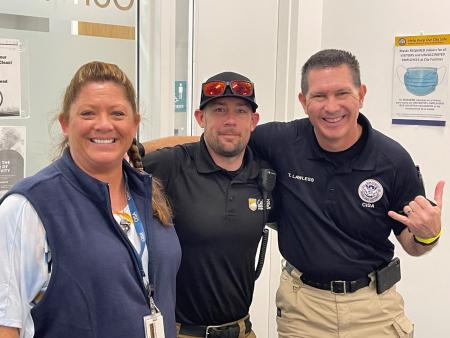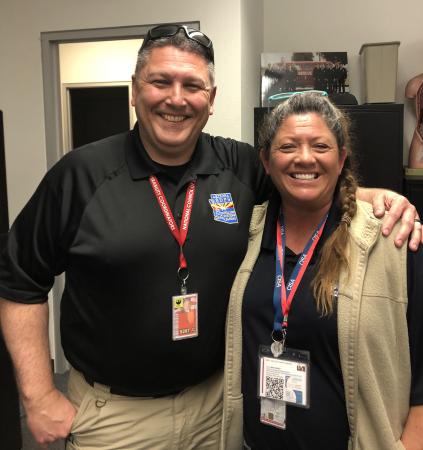April is Emergency Communications Month! Meet Region 9 Emergency Communications Coordinator Artena Moon
What is emergency communications?
My definition of emergency communications has evolved over the years. When I enlisted in the miltiary as a multi-channel technical operator, I thought emergency communications meant mountaintop relay sites, radios, antennas, frequencies, phone systems, encryption, cyber defense and security. When I became an electronics technician in the Naval Reserve emergency communications expanded to mean sonar, satellite, electrical and electronics concepts. And as a Signal Officer, it expanded to coverage areas, ground-to-air planning, fixed and moving comms, jamming, hopping, video, staffing, storage, frequency management, cybersecurity, IT services, servers, switches, call managers, continuity of operations (COOP) plans, costs, and codes. Emergency communications is an accumulation of signal mediums over which a myriad of content can flow. Keeping that infrastructure functioning, secure and accessible to those making decisions is how the term emergency communications has evolved.
What is your job title?
I’m an Emergency Communications Coordinator. I split Region 9 with my partner, Tom Lawless. I cover Arizona, Northern California and Nevada, while he covers Southern California, Hawaii and the Pacific.
What you do for CISA?
I work with the Statewide Interoperability Coordinators to inform leadership decisions regarding emergency communications resilience. Specifically, Emergency Communications Coordinators help build the strategic roadmap for continued interoperable improvement for states, counties and tribes in California, Arizona and Nevada. Every day is different because every stakeholder has unique skills, technology and goals. As an Emergency Communications Coordinator, I provide scalable, skill-building resources in the form of Technical Assistance programs such as individualized radio operator, IT service leader, tactical cyber awareness and dispatching, incident center manager, communications leader training courses, and the governance and operational offerings to assist in building their own plan.
Beyond the individualized training, the job goes from fun to super fun! I get to work on developing unique Communications exercises, alert and warning plans, opertional assessments, gap analysis and engineering studies to identify critical links and planning gaps. I get to work with stakeholders, such as the Lake Tahoe Regional Fire Chief Association to bring together multiple agencies, counties and states under a common goal, to communicate. It is most fun when law enforcement, healthcare, aviation, fire, public safety, emergency management and transportation all come to the table and say, let’s build a unified Communication Plan—that is Disneyland-fun!
When did you start working for CISA?
I started working at CISA in July 2019.
What is your professional background? Where did you work before coming to CISA?
Emergency communications is my passion and everything I do is to become a Master Communicator. I enlisted in the Army National Guard Signal Corps at age 17 and spent a decade learning and mastering military radio, electronics, and electricity, to include a couple years in the Naval Reserve as an Electronics Technician. I spent the next decade of my military career as a Signal Officer learning the management, planning, staffing, training, security, encryption, and resource requesting of communication assets and personnel. My final tour was to Iraq as the Signal Officer In-Charge for the 40th Combat Aviation Brigade from 2010 to 2011. Simultaneously, I worked various telecommunications, engineering and IT jobs in the civilian sector, including at KELO-TV in South Dakota.
In 2013, I retired from the military and left federal service to launch MoonCom along with five of my closest friends. Our niche was emergency communication plans, exercises and communication cards. During that time, I earned an MBA and a master’s degree in Organizational Leadership from Brandman University; an Executive Degree in Project Management from UC Davis; and a doctorate in Organizational Change and Leadership from the University of Southern California.
Just prior to joining CISA, I worked at California Office of Emergency Services (CalOES) as a project manager where I was in charge of GIS fire mapping software, WebEOC, Emergency Management Assistance Compacts (EMACs), Alerts and Warning, and the State Operation Center Technologies.
What attracted you to CISA?
I was attracted to CISA because it is the top of the ladder for Emergency Communications in the country and the place to begin global communication talks, which includes interplanetary communications initiatives.
What do you like most about your job?
As an emergency communicator, I get to serve people that want to interoperate and break down silos. I get to bring people together to do the good work—I am blessed.
###

As emergency communications coordinators, Artena Moon (left) and Tom Lawless (right) work closely with federal, state, local, tribal and territorial partners, such as with Devin Clarke (center), California Office of Emergency Services (CalOES)’s Deputy Statewide Interoperability Coordinator.

Jeremy Knoll, Arizona Statewide Interoperability Coordinator (SWIC) for the Arizona Department of Public Service, and CISA Region 9 Emergency Communications Coordinator Artena Moon provided emergency communications support during Super Bowl LVII on Feb. 12 at State Farm Stadium in Glendale, Arizona.




